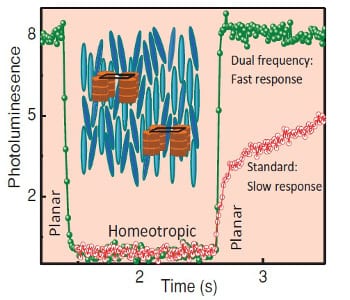 Materials which can switch their photoluminescence in a reversible manner are important in several fields, such as ultrahigh-density optical data storage, molecular switches and wires, opto-electronic devices, sensors, organic light-emitting diodes, and genetic probes.
Materials which can switch their photoluminescence in a reversible manner are important in several fields, such as ultrahigh-density optical data storage, molecular switches and wires, opto-electronic devices, sensors, organic light-emitting diodes, and genetic probes.
A wide variety of luminescent polymers and organic materials have been developed to cater to these needs. However, the deployment of these materials for practical applications suffers principally from drawbacks such as a low contrast (a low ON/OFF intensity ratio, making it difficult to distinguish the two states), irreversibility, or a slow response time.
Although the intrinsic anisotropy of liquid crystalline photoluminescent materials could address the contrast problem, the associated dynamics are slow, in the range of seconds.
A group of researchers working in India have managed to address this issue by preparing composites of the host dual-frequency response liquid crystal material and a photoluminescent disc-like molecule.
A two-frequency protocol utilized to drive the photoluminescent composite between two anisotropic states (ON and OFF) brings about a dramatic acceleration in the dynamics, yielding responses that are two orders of magnitude faster, while also enhancing the fluorescence contrast.
The protocol has built-in adaptability in terms of the magnitude and frequency of the field required to get intermediate values of the contrast, creating a “grey scale”. The finding is attractive from the viewpoint of fast fluorescence imaging, the detection of action potentials in neurons, and for photoluminescent displays.

















